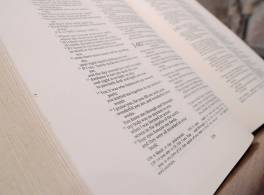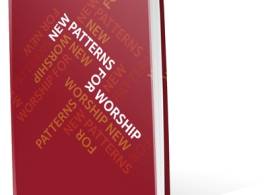Worship may often make use of the authorized provision for A Service of the Word, which is given here for ease of reference.
A Service of the Word
¶ Introduction
A Service of the Word is unusual for an authorized Church of England service. It consists almost entirely of notes and directions and allows for considerable local variation and choice within a common structure. It is important that those who prepare for and take part in A Service of the Word should have a clear understanding of the nature of worship and of how the component parts of this service work together. Leading people in worship is leading people into mystery, into the unknown and yet the familiar. This spiritual activity is much more than getting the words or the sections in the right order. The primary object in the careful planning and leading of the service is the spiritual direction which enables the whole congregation to come into the presence of God to give him glory. Choices must be made responsibly by leaders of this service or by groups planning worship with them, whether the service is an occasional one, or a regular one which may use a service card. The notes and the text of A Service of the Word should be read together as they interpret one another.
The Liturgy of the Word
At the heart of the service is the Liturgy of the Word. This must not be so lightly treated as to appear insignificant compared with other parts of the service. The readings from Holy Scripture are central to this part and, together with the season, may determine the theme of the rest of the worship. At certain times of the year, as Note 5 says, the readings come from an authorized lectionary, so that the whole Church is together proclaiming the major events in the Christian story. Telling that story and expounding it in the ‘sermon’ can be done in many different and adventurous ways. Some are suggested in Notes 5 and 7, but there are many others. The word ‘sermon’ is used in the service, and explained in the note, precisely because it would be too limiting to use words like ‘address’, ‘talk’, ‘instruction’, or ‘meditation’.
The items in the Liturgy of the Word may come in any order and more than once. So the sermon may be in parts and there may be more than one psalm or song, and of course hymns may be inserted as well. But on most occasions it will be appropriate for this part of the service to have a Creed or Affirmation of Faith as its climax.
Preparation
With the Liturgy of the Word becoming clear it will be easier to see how the Preparation for it, and the response to it in the Prayers, fit in. People need to know when the service has started (Note 1). What happens at the beginning can create the atmosphere for worship and set the tone and mood for what follows. The gathering of the congregation and the call to worship are to be marked by a liturgical greeting between minister and people. Leaders should have worked out exactly where this comes among the singing, Scripture sentence, introduction (perhaps to the theme) and opening prayer. All these should draw the members of the congregation together and focus their attention on almighty God.
This part of the service will usually include the Prayers of Penitence, though these may come later if, for instance, the theme of the Liturgy of the Word appropriately leads to penitence. Authorized Prayers of Penitence include all those confessions and absolutions in The Book of Common Prayer and in services in Common Worship, together with several other seasonal and thematic forms, mostly for occasional use, which are set out on pages 122-137 of Common Worship. The climax of this part of the service is either the Collect or, if that is included in the Prayers, one of the items of praise, a hymn or the Gloria. The Collect does not have to be that of the day; it may be a thematic one based on the readings (in which case it should come immediately before the readings), or be used to sum up the Prayers.
Prayers
Part of the response to the Word is the Creed, but the response should be developed in the Prayers which follow. There are many different options for this part of the service. These range from a series of Collect-type prayers to congregational involvement in prayer groups, visual and processional prayers, with responsive forms and a number of people sharing the leading of intercessions in between. But, whatever the form, it is essential that the Prayers also include thanksgiving. A section of thanksgiving, which may include the spoken word, music and hymns, may be the proper climax to this part of the service.
Conclusion
Many different words have been used for the Conclusion, each of which has something to contribute to our understanding of how the service ends: dismissal, farewell, goodbye, departure, valediction, commission, blessing, ending, going out. What is essential, as with the way the service starts, is that it should have a clear liturgical ending: options are listed in Note 9.
Once the service is planned, leaders will want to check through to ensure that there is the right balance between the elements of word, prayer and praise, and between congregational activity and congregational passivity. Does the music come in the right places? Is there sufficient silence (Note 4)? This is something leaders can be afraid of, or fail to introduce properly. And is there a clear overall direction to the service: is it achieving the purpose of bringing the congregation together to give glory to God?
¶ A Service of the Word
Preparation
The minister welcomes the people with the Greeting.
Authorized Prayers of Penitence may be used here or in the Prayers.
The Venite, Kyries, Gloria, a hymn, song, or a set of responses may be used.
The Collect is said either here or in the Prayers.
The Liturgy of the Word
This includes
¶ readings (or a reading) from Holy Scripture
¶ a psalm, or, if occasion demands, a scriptural song
¶ a sermon
¶ an authorized Creed, or, if occasion demands, an authorized Affirmation of Faith.
Prayers
These include
¶ intercessions and thanksgivings
¶ the Lord’s Prayer
Conclusion
The service concludes with a blessing, dismissal or other liturgical ending.
¶ A Service of the Word with a Celebration of Holy Communion
This rite requires careful preparation by the president and other participants, and is not normally to be used as the regular Sunday or weekday service.
Sections marked with an asterisk * must follow an authorized text.
Preparation
The people and the priest:
¶ greet each other in the Lord’s name
¶ confess their sins and are assured of God’s forgiveness*
¶ keep silence and pray a Collect*
The Liturgy of the Word
The people and the priest:
¶ proclaim and respond to the word of God
Prayers
The people and the priest:
¶ pray for the Church and the world
The Liturgy of the Sacrament
The people and the priest:
¶ exchange the Peace
¶ prepare the table
¶ pray the Eucharistic Prayer*
¶ break the bread
¶ receive Holy Communion
The Dismissal
The people and the priest:
¶ depart with God’s blessing.
¶ Notes
In this form of service, the material is described as ‘authorized’ or ‘suitable’, which expressions shall have the following meanings:
¶ ‘authorized’ means approved by the General Synod in accordance with the provisions of Canon B 2.
¶ ‘suitable’ means a form used at the discretion of the minister conducting the form of service on any occasion, but such that the material so used shall be neither contrary to, nor indicative of any departure from, the doctrine of the Church of England in any essential matter.
This service is authorized as an alternative to Morning Prayer and Evening Prayer. It provides a structure for Sunday services, for daily prayer and for services of an occasional nature.
1 Greeting
The service should have a clear beginning. The liturgical greeting may follow some introductory singing, or a hymn or a sentence of Scripture, and may be followed by a brief introduction or an opening prayer.
2 Prayers of Penitence
Only authorized Prayers of Penitence should be used. They may be omitted except at the Principal Service on Sundays and Principal Holy Days. Authorized forms of Confession and Absolution may be found in The Book of Common Prayer, in the services in Common Worship and on pages 122-137 of Common Worship. See also here. The minister may introduce the Confession with suitable words.
3 Hymns, Canticles, Acclamations and the Peace
Points are indicated for some of these, but if occasion requires they may occur elsewhere.
4 Silence
Periods of silence may be kept at different points of the service. It may be particularly appropriate at the beginning of the service, after the readings and the sermon, and during the prayers.
5 Readings
There should preferably be at least two readings from the Bible, but it is recognized that if occasion demands there may be only one reading. It may be dramatized, sung or read responsively. The readings are taken from an authorized lectionary during the period from the Third Sunday of Advent to the Baptism of Christ, and from Palm Sunday to Trinity Sunday. When A Service of the Word is combined with Holy Communion on Sundays and Principal Holy Days, the readings of the day are normally used.
6 Psalms
The service should normally include a psalm or psalms. These might be said or sung in the traditional way, but it is also possible to use a metrical version, a responsive form or a paraphrase such as can be found in many current hymn books. The psalm may occasionally be replaced by a song or canticle the words of which are taken directly from Scripture: a ‘scriptural song’.
7 Sermon
The term ‘sermon’ includes less formal exposition, the use of drama, interviews, discussion, audio-visuals and the insertion of hymns or other sections of the service between parts of the sermon. The sermon may come after one of the readings, or before or after the prayers, and may be omitted except on Sundays and Principal Holy Days.
8 Sermon and Creed
The sermon, and a Creed or authorized Affirmation of Faith may be omitted except at the principal service on Sundays and Principal Holy Days.
9 Ending
The service should have a clear ending. This takes one or more of the following forms: the Peace, the Grace or a suitable ascription or blessing. If a responsive conclusion is used, it comes last.
10 A Service of the Word with a Celebration of Holy Communion
An order for this is provided (see page 25 of Common Worship). The notes to the Order for the Celebration of Holy Communion (pages 158-159 and 330-335 of Common Worship) apply equally to this service. In particular the Note on Ministries (pages 158-159 of Common Worship) specifies that the president must be an episcopally ordained priest, but indicates that where necessary a deacon or lay person may preside over the Preparation and the Liturgy of the Word, including the Prayers. The order provided is not prescriptive.
New Patterns for Worship, material from which is included here,
is copyright © The Archbishops' Council 2002 and published by Church House Publishing.


